Related Research Articles

Johnny Weissmuller was an American Olympic swimmer, water polo player and actor. He was known for having one of the best competitive-swimming records of the 20th century. He set world records alongside winning five gold medals in the Olympics. He won the 100m freestyle and the 4 × 200 m relay team event in the 1924 Summer Olympics in Paris and the 1928 Summer Olympics in Amsterdam. Weissmuller also won gold in the 400m freestyle, as well as a bronze medal in the water polo competition in Paris.

Cheeta is a chimpanzee character that appeared in numerous Hollywood Tarzan films of the 1930s–1960s, as well as the 1966–1968 television series, as the ape sidekick of the title character, Tarzan. Cheeta has usually been characterized as male, but sometimes as female, and has been portrayed by chimpanzees of both sexes.

Tarzan and the Leopard Woman is a 1946 American action film based on the Tarzan character created by Edgar Rice Burroughs and portrayed by Johnny Weissmuller. Directed by Kurt Neumann, the film sees Tarzan encounter a tribe of leopard-worshippers. It was shot in the Los Angeles County Arboretum and Botanic Garden. Its plot has nothing in common with Burroughs' 1935 novel Tarzan and the Leopard Men.
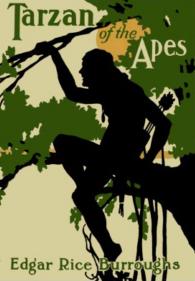
Tarzan of the Apes is a 1912 novel by American writer Edgar Rice Burroughs, and the first in the Tarzan series. The story was first printed in the pulp magazine The All-Story in October 1912 before being released as a novel in June 1914.
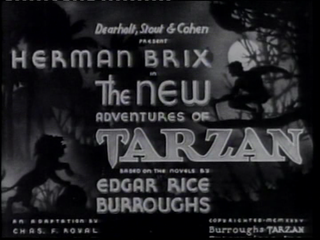
The New Adventures of Tarzan is a 1935 American film serial in 12 chapters starring Herman Brix. The serial presents a more authentic version of the character than most other film adaptations, with Tarzan as the cultured and well-educated gentleman in the original Edgar Rice Burroughs novels. It was filmed during the same period as the Johnny Weissmuller/Metro-Goldwyn-Mayer Tarzan films. Film exhibitors had the choice of booking the serial in 12 episodes, the feature film, or the feature film followed by 11 episodes of the serial.
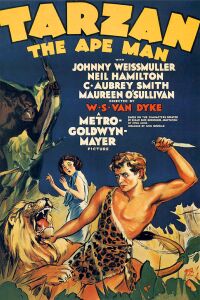
Tarzan the Ape Man is a 1932 pre-Code American action adventure film released by Metro-Goldwyn-Mayer featuring Edgar Rice Burroughs' Tarzan and starring Johnny Weissmuller, Neil Hamilton, C. Aubrey Smith and Maureen O'Sullivan. It was Weissmuller's first of 12 Tarzan films. O'Sullivan played Jane in six features between 1932 and 1942. The film is loosely based on Burroughs' 1912 novel Tarzan of the Apes, with the dialogue written by Ivor Novello. The film was directed by W.S. Van Dyke. Metro-Goldwyn-Mayer released two remakes of Tarzan, the Ape Man in 1959 and in 1981, but each was a different adaptation of Rice Burroughs' novel. It is also the first appearance of Tarzan's famous yell.
The Tarzan yell or Tarzan's jungle call is the distinctive, ululating yell of the character Tarzan as portrayed by actor Johnny Weissmuller in the films based on the character created by Edgar Rice Burroughs starting with Tarzan the Ape Man (1932). The yell was a creation of the movies based on what Burroughs described in his books as simply "the victory cry of the bull ape."

Korak, a fictional character, is the ape name of John "Jack" Clayton III, the son of Tarzan and Jane Porter.
Jean-Paul "Picha" Walravens is a Belgian cartoonist, comics artist, animator and film director. He is most famous for his adult animated films, such as Tarzoon: Shame of the Jungle.

Jane Porter is a fictional character in Edgar Rice Burroughs's series of Tarzan novels and in adaptations of the saga to other media, particularly film. Jane, an American from Baltimore, Maryland, is the daughter of professor Archimedes Q. Porter. She becomes the love interest, later the wife of Tarzan and subsequently the mother of their son, Korak. She develops over the course of the series from a conventional damsel in distress, who must be rescued from various perils, to an educated, competent and capable adventuress in her own right, fully capable of defending herself and surviving on her own in the jungles of Africa.

Tarzan and the Mermaids is a 1948 American adventure film based on the Tarzan character created by Edgar Rice Burroughs. Directed by Robert Florey, it was the last of twelve Tarzan films to star Johnny Weissmuller in the title role, with the following sixteen films in the series featuring alternating actors between main and supporting, while maintaining a single continuity. It was also the first Tarzan film since 1939 not to feature the character Boy, adopted son of Tarzan and Jane.
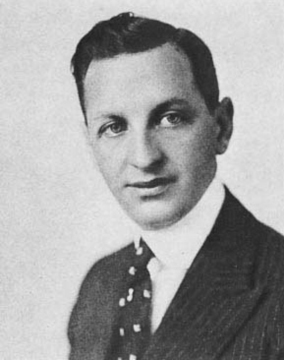
Sol Lesser was an American film producer. He received a star on the Hollywood Walk of Fame in 1960 and was awarded the Jean Hersholt Humanitarian Award in 1961.

Tarzan Finds a Son! is a 1939 Tarzan film based on the character created by Edgar Rice Burroughs. It was the fourth in the MGM Tarzan series to feature Johnny Weissmuller as the "King of the Apes" and the fourth of six films in which he stars with Maureen O'Sullivan as Jane; following this pairing was Tarzan's Secret Treasure (1941) and Tarzan's New York Adventure (1942).

Tarzan and the Lion Man is a novel by American writer Edgar Rice Burroughs, the seventeenth in his series of twenty-four books about the title character Tarzan. The novel was originally serialized in the magazine Liberty from November 1933 through January 1934.
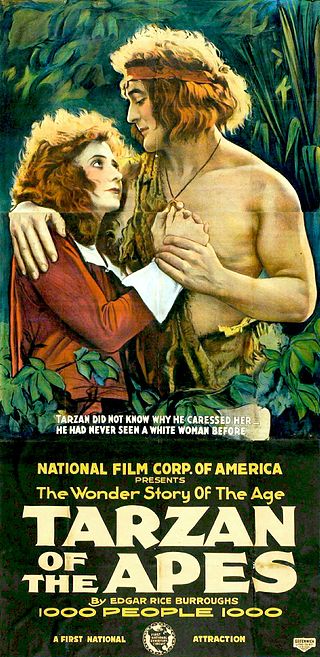
Tarzan, a fictional character created by Edgar Rice Burroughs, first appeared in the 1912 novel Tarzan of the Apes, and then in twenty-four sequels by Burroughs and numerous more by other authors. The character proved immensely popular and quickly made the jump to other media, first and most notably to comics and film.

Tarzan's Secret Treasure is a 1941 American adventure film directed by Richard Thorpe and starring Johnny Weissmuller, Maureen O'Sullivan and Johnny Sheffield. Based on the Tarzan character created by Edgar Rice Burroughs, it is the fifth in the MGM Tarzan series to feature Weissmuller and O'Sullivan. Original prints of the film were processed in sepiatone.

Tarzan the Fearless is a 12 chapter American Pre-Code film serial starring Buster Crabbe in his only appearance as Tarzan. It was also released as a 61-minute feature film which consisted of the first four chapters edited together, and which was intended to be followed on a weekly basis by the last eight chapters in individual episode format, but which was often exhibited instead as a stand-alone feature film. Actress Jacqueline Wells co-starred; she later changed her name to Julie Bishop. The serial was produced by Sol Lesser, written by Basil Dickey, George Plympton and Walter Anthony, and directed by Robert F. Hill. The film was released in both formats on August 11, 1933.

Nkima is a fictional character in Edgar Rice Burroughs' Tarzan novels, and in adaptations of the saga to other media, particularly comics. His name comes from either the word N'kima, or, after the Meru language nickname for Ugali, a dish popular in Kenya and Tanzania made from maize flour.

Tarzan is a fictional character, a feral child raised in the African jungle by the Mangani great apes; he later experiences civilization, only to reject it and return to the wild as a heroic adventurer.
Scott Tracy Griffin is an American writer, actor and "one of the world's leading experts" on author Edgar Rice Burroughs and his works. He is the author of Tarzan: The Centennial Celebration, the "only official commemorative illustrated history" of Burroughs' literary character Tarzan, which book was a 2013 Locus Award finalist for Best Art Book.
References
- 1 2 3 John Hartl (June 1, 1997). "'Investigating Tarzan' Uncovers The Apeman". The Seattle Times . Retrieved May 16, 2011.
- ↑ "Tarzan Still Swingin' After All These Years". Free Lance-Star . June 5, 1997. p. 46. Retrieved May 16, 2011.
- ↑ "Tarzan Swings Again; In the Jungle of Our Memories, He'll Always Be King". The Washington Post . June 6, 1997. pp. B.01.
- ↑ "Tarzan Swung Through a Jungle of Innocence". Sun Herald. June 6, 1997. pp. A10.
{{cite web}}: Missing or empty|url=(help) - ↑ Diane Werts (June 5, 1997). "They Were Swingers Then". Newsday .
- ↑ "Investigating Tarzan". Informactionfilms.com. Archived from the original on 2010-01-04. Retrieved 2010-06-27.
- ↑ Johnny Weissmuller, W. Craig Reed (2002). Tarzan, My Father. ECW Press. pp. 13, 215–216. ISBN 1-55022-522-7.